Unfolding:Electric Field
INTRO
Electric Field is:
- a reimagining of the wind turbine, without extractive use of minerals and land
- a method for regenerative prototyping
- a DIY micro energy wind turbine for hands-on experimenting with energy and regeneration!
AGAINST ENERGY MONOCULTURES
Electric Field asks,
What kinds of energy imaginaries can we generate when working with principles of regeneration, soil health and community empowerment as core propositions for creative prototyping?
Despite a focus on sustainable energy transitions, monumental wind turbine projects keep the energy hungry engines of racial capitalism spinning, obscuring interdependencies of energy, agriculture and communities. With Electric Field, the Regenerative Energy Communities project explores how it might be possible to challenge existing paradigms of energy and the so-called “green transition” by working closely with propositions of regenerative farming and agroecology in order to develop regenerative energy alternatives.
In an age of both sedimented and emergent proposals for energy by a range of actors and communities, how might we think of experimentations with energy alternatives as not just aimed at, for example, individual home owners or off-grid prepper isolationism? What happens when we don’t default to the same old menu of the solar panel or large-scale wind turbine? We don't need more neoliberalist design projects and smart city notions of the good citizen. Perhaps instead an energy community could be…
…a group of queer teenagers hacking a crystal in a community centre
…a rowing club wanting to use the intimate flows of water currents to power post-rowing social activities
…a fermenting revolt spilling out of a militant action of infrastructuring and resistance.
At a negative infrastructure moment (e.g., Fortress Europe, Amazon, Monsanto) when a new wave of mining of rare earth metals in indigenous Northern European lands and elsewhere will only further accelerate ongoing damages relating to energy demands (see, for instance, the writings of resistance group Kolonierna on this matter: https://kolonierna.se/zines/), how might we cultivate alternative practices in opposition to the dominant infrastructures and monocultures of energy and agriculture? When Europe is withdrawing funding from cultural programs, when it is no longer possible in parts of europe for students to run their own (abolitionist) radio stations––In the end times, how to design with joy and care?
Electric Field is a small attempt at working to imagine energy alternatives that take biodiversity, soil health and non-extractive uses of land and minerals as core propositions for creative experimentation with energy. It can be tried out in hands-on collective workshops with others (e.g., https://regenerative-energy-communities.org/events/symposium-on-artistic-research-in-a-time-of-change) and we share it here in this zine for anyone to experiment and iterate upon. Most of all, Electric Field is committed to a core ongoing aim of the Regenerative Energy Communities, namely the question of
How can we make space for communities to feel that both food (farming) and energy (electricity + electronics) are not something that is done to us, but that we do?
METHODS FOR REGENERATIVE PROTOTYPING
Prototyping for energy alternatives can take different directions when working across the intersections of energy and agriculture. In our work, we have been inspired by propositions emerging from regenerative agriculture and movements in agroecology more generally. To name just a few examples of practitioners working with approaches to regeneration and agroecology: La Vía Campesina’s international farming movements https://viacampesina.org/en/, Leah Penniman’s book Farming While Black, the ‘Alternatives Confluence’ approaches of Vikalp Sangam https://vikalpsangam.org/). Each of these groups, in their own situated manners, aim to develop approaches to farming and agriculture that carefully consider how both ecological and community health and resilience might be co-developed commitments for actions and decision making.
The prototyping of Electric Field grew out of a challenge of how might we design a microenergy prototype for the farming community that we work with in Växjö, Sweden, that would respect the principles and commitments of this regenerative farming community. Amongst others, these include commitments to
- use already existent, locally sourced biodegradeable materials wherever possible (e.g., e-waste from recycling centres, materials from second hand stores, etc.)
- source materials from within 6km radius of the farm wherever possible (e.g., a manageable biking distance)
- only bring materials onto the farm that are beneficial to soil health (e.g., no plastics, toxic materials, etc.)
- prioritise ongoing improvement of soil and biodiversity health in all activities on the farm (cleaning up, healing and restoring first!)
- support and sustain abolitionist multispecies communal flourishings in the form of energy giving outcomes (e.g., food sovereignty, social relations, and always asking what have you done about inequality today?)
It is important to point out that propositions like the above can act as method in the making for anyone wanting to begin experimenting with imagining and devising regenerative prototypes of their own!
In developing one’s own version or fork of Electric Field, what materials might one end up with when committing to propositions such as the above? What already existent components are within a bikeable distance for working with? What are local needs in terms of soil and biodiversity health that your prototype can address, and how might this effect the design of the piece? What communities do you want to sustain and support in your prototyping? How to scavenge, retool, rescale and reassemble a diversity of parts and relations into imaginative and generative contraptions for multispecies and interdependent community solidarity?
As speculatively functional or functionally speculative as the results might originally be in some cases (to quote from project member Miranda Moss’s description of elements of our work), we propose that committing to such regenerative propositions can act as method (of sorts) able to support new approaches to imagining and prototyping energy and agriculture alternatives.
Whatever form and direction such a regenerative approach might take you, we stress the value of experimentation with others as a form of community building. Working on electric field has brought us into contact with a range of what we might call emergent energy communities - though notably not what are perhaps typically thought of as energy communities. Beyond those involved on the farm site, we have gotten to know Växjö’s second hand communities, where many of the materials have been sourced from. We began the project with regular interfacing with the municipality’s recycling center (getting both our compost and disregarded electronics from the the same place!). When harvesting the reeds from the lake ecosystem, walkers around the lake regularly stop to ask us questions about what we are doing, creating further potential spaces of learning collective sharing of knowledges.
MATERIAL STORIES
In sourcing regenerative materials that are both grown directly from the soil and foraged from various local sites and ecosystems, we find ourselves forming a different relation to matter and energy, and our project working actively to develop this sense of getting closer to the materiality of energy. We believe it is an important shift to imagine energy (but also artistic and design) communities starting from the soil rather than modes of control and monitoring of energy use.
In terms of our ongoing work on different prototypes, one of the key challenges has been that of striving as much as possible to only use biodegradables and non-extractive materials. The current stewards of the Brände Udde farming site, VXO Farm Lab, give out a booklet to all newcomers wanting to work on the space. In its pages, they include the following request for consideration by all working on the site:
“Only Biodegradables: We aim to abolish all use of petrochemicals at our sites. That means: no use of plastics or synthetic materials (if reasonably possible). If it can’t become food to your plants it shouldn’t be at the site!” (VXO Farm Lab)
In the case of Electric Field, this and the previously mentioned regenerative commitments have resulted in us
- harvesting common reeds from the local lake outside of the farm as organic regenerative material for the wind-cathcing function of the turbine,
- scavenging for wood materials from the offshoots of the university’s wood workshop,
- visiting the local thrift second hand store to pickup discarded landline telephones and children’s toys in order to disassemble them for piezo sensors,
- surplus beeswax (instead of glue) harvested from the farm,
- sourcing and preparing mushroom dowel plugs for the mycoremediation element of the piece aimed at soil health,
- running workshops and creating a zine for sharing this knowledge with others!
Each of the components of electric field have material stories in them. Here are just a few from the first incarnaction of Electric Field that we put together.
Phragmites Australis / The common reed / Vass / bladvass
The lakes in Växjo have a long history of battling eutrophication; a process whereby too many nutrients accumulate in a body of water, particularly nitrogen and phosphorous from degenerate farming methods relying on excessive use of chemical fertilizers, which lead to a number of negative knock-off effects. Lake Trummen, whose water we irrigate our farm with, and which also eventually leads out to the Baltic sea, is no exception. In the marshy shores of the lake, phragmites australis, which thrives in eutrophied waters, grow in dense thickets, throttling biodiversity as they take advantage of these conditions, for which they become a bio-indicator. However, these reeds are not all bad - they provide important, calm breeding grounds and hiding spaces for many species (including the mosquito, unfortunately!).
Most interestingly, these reeds are proficient at taking these surplus of nutrients out of the water. However, these reeds need to be harvested to remove the nutrients from the site, otherwise they will decay in the water and release them again (Sundblad & Wittgren 1989). To aid with recalibrating the balance of the ecosystem, we have been thinning out these dense ‘fields’ to use the reeds as biodegradeable and soil enriching forms of wind-catching alternatives to turbine blades.
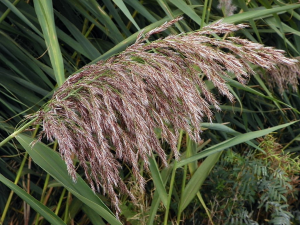
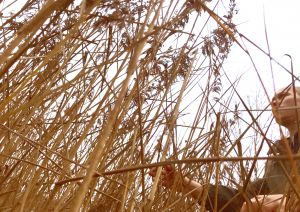
Piezo buzzers
Piezo buzzers will be our generator, which means they will be the things generating the electricity. They are ubiquitous in electronic devices—and thus in e-waste—and are used in anything that beeps, buzzes or plays simple tunes. Some examples include telephones, smoke detectors and other alarm-y things, electric doorbells, ultrasonic humidifiers, toys that make sound, and more.
As we know them as sound makers, piezo buzzers work because you feed the piezo an electric current, and this signal makes the piezo vibrate at different frequencies and intensities, which we hear as sound. However, if you reverse the process by ‘vibrating’ the buzzer, you will get an electric current! The word “piezo” comes from the Greek for “pressure” or “push” - so piezoelectricity is basically electricity that is created through pressure, or mechanical strain.
We see cleaning up our surrounding ecosystems as also very much including the techno-ecosystems. Of course, in a few years, there probably won’t be any landline telephones in the dump / second hand store (we have to ask for them, they don’t bother to even try sell them) - but we see this as a way to clean up (obsolete tech…) now, with what we have available at our local space/time scale.
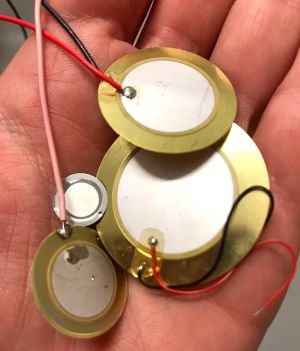
Piezo buzzers come in quite a lot of sizes, and sometimes have plastic casings on them. However in devices like old telephones, the case, used for resonance, is built into the design.
We’ll have to insulate the piezos, as we’re worried about the metals leeching into the soil! We think some even have some lead composite in the piezo ceramic material - eek! We hope to grow our own piezo elecric crystals soon, such as with Rochelle Salts or Onion Skins. To put this into perspective, wind turbine generators use a huge amount of copper and rare earth magnets, and look something like this:
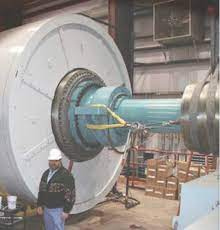
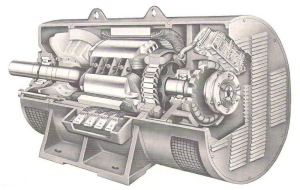
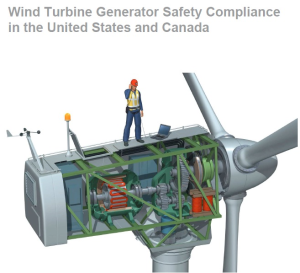
Oyster mushrooms
Pleurotus ostreatus are proficient at soaking up (and metabolising) heavy metals and other contaminants - a concern for all urban farms. We have a main road which runs past our farm, which presumably our soil has a fair amount of pollution from.
Oyster mushrooms are also capable of growing both in soil, and on wood, which is necessary for this design. We used mycelium-innoculated wooden dowel plugs, which you can manufacture yourself (e.g., https://www.youtube.com/watch?v=4mHbt-5fimY).
Wood
These wooden cylinders were salvaged from scrap at LNU's department for sustainable structural engineering. The long poles, made from pine, were cut into shorter pieces and then sliced in half length-ways. Presumably rectangular-shaped rods would work fine too, or whatever you can find - however, the type of wood is important to grow the particular species of mushroom on (see this page for advice on mushroom substrates: https://learn.freshcap.com/growing/understanding-mushrooms-substrates/). These columns would constitute Electric Fields humble foundation and mast.
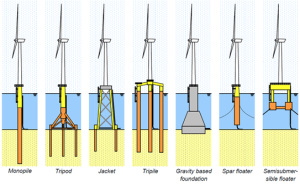
Beeswax
To plug the mycelium dowels, and for any mechanical securing, we used beeswax. Henrik, one of the farmers at our Brände Udde farm site, keeps bees!
HOW TO MAKE IT FROM SCRATCH
OUTPUT
Bridge rectifier
Most of the smaller electronics we interact with on a daily basis use direct current (DC), such as batteries, USB-powered devices and other chargers, which often work with standards of 1.5v, 5v, 12v and 24 volts. Alternating current (AC) on the other hand is usually associated with the high voltage electricity we get from wall plugs (240 volts), and in the transmission lines running around and between cities. Why we use DC and AC for these different purposes has somewhat to do with their physical properties, but is also due to the turbulent saga of “The current wars” in 20th century USA, demonstrating how firmly rooted in toxic capitalism our electrical systems are (see, for instance, Th. Metzger’s book Blood and Volts: Edison, Tesla and the Electric Chair).
Piezo electric generators, however, actually produce AC current. Since we’ll be using the power with our small electronics using DC, we’ll have to make a little circuit to turn this AC into DC, using diodes. Diodes (you might know the term from LEDs - Light Emitting Diodes), allow electricity to flow only in one direction.
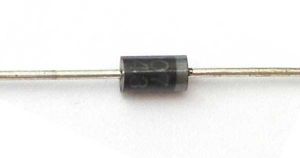
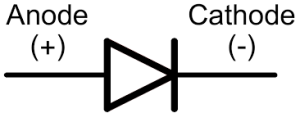
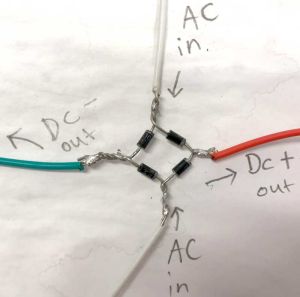
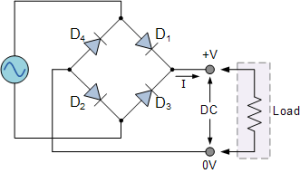
You can probably use any type of diode that looks like this, but they all have slightly different specifications, like how much current they can handle, and what the voltage drop is of the electricity as it flows through.
We used 1N4001 diodes, which have high current capability and low forward voltage drop.
Feral sensing circuits
We used this ultra low powered analogue synthesizer that our fellow geek and low-energy artist Ralf Schreiber showed us. It uses a microchip called a hex inverter and a few passive components. It’s a very simple voltage controlled oscillator, which means that you can hear the electrical activity. This is also nice for sensing what’s going on with our generators, without using measuring devices, which are not quite suitable for this unstable power.
PUTTING TOGETHER
With all of these components in place, we are then able to build our electric field.
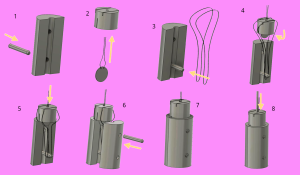
Thanks to the magical and reversible properties of piezoelectric crystals, when a gust of wind blows upon the field of reeds, electricity is generated from these small, kinetic movements, in this case powering the feral circuit’s small music synthesizer generating the sounds.
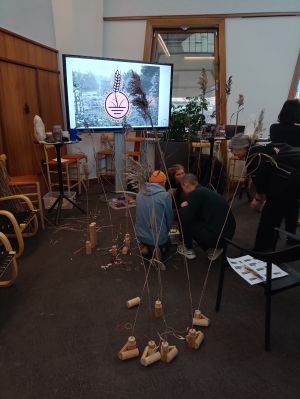
TAKE THIS ENERGY!
And that is how we ended up with our technoecological microenergy wind turbine. Whether it be the prototype itself, the regenerative methods, or the material stories that it holds, we hope Electric Field can act in someway as inspiration for experimenting together with propositions of energy and regeneration. We want energy and farming to be something we do, rather than that is done to us. And we believe it is an important shift to imagine energy beyond modes of efficiency, control and monitoring of energy use.
We continue to work in our project on developing ways of getting closer to the materiality of energy and the possibilities of regenerative approaches to making and living together. And in doing so, to cultivate paradigms of energy and agriculture that are able to break through standard technoscience approaches. As project member Helen Pritchard has put it, a regenerative practice works with complex, deep arrangements of the everyday. It is a practice of making or recovering knowledge within oppressive systems, and how this knowledge can fortify us and our communities. A regenerative practice queers geochemistries designing for material resistance across scales - because how we understand and make sense of energy, how we practice with matter and energy shapes how we do what we do.
Electric Field is a farming for energy alternatives. It is composed of material mappings, stories and kinetic explorations. It is that rare breed - electricity as beneficial waste product! And it can be done in your own locale and community, with your own practices, dreams and regenerative, micro energy fantasies.
If you do try this out, please feel free to share your experiments and stories with us, we would be happy to discuss and share on our website!: team@regenerative-energy-communities.org
Finally, we would like to thank the Brände Udde farmers, VXO Farm Lab, participants in our “Growing (with) Mushroom” and “Word Becomes Energy” open labs (big thx to Fred Carter who ran the second of these!), and also participants in our” Wind As Regeneration” workshop in Luleå for inspiring and conspiring on this work!
wiki-to-pdf: how this publication was made
This publication (whether you are holding it in its paper format or looking at it on a screen) has been written and laid out with a wiki-to-pdf system installed at http://titipi.org/wiki-to-pdf. The code and ongoing documentation of the system is hosted at https://gitlab.constantvzw.org/titipi/wiki-to-pdf
wiki-to-pdf
wiki-to-pdf is a contraption for ongoing publication efforts. It combines the collaborative editing possibilities of Mediawiki with the pdf-in-the-browser approach of the pagedjs library to produce paginated, elastic, malleable and re-editable publications for printing and on-line reading.
The system proposes a hybrid publishing toolkit that blurs the boundary between digital and printed publication. It enables different workflows and labour division that divert from the traditional publishing models in which textual and visual material are submitted to a designer that carefully works towards a final layout of the materials. In wiki-to-pdf the work on content and design happens in parallel on the very same system: the CSS files that set the style for the publication are stored in a wiki page, just like all the texts and images that compose the book content. This allows continuous re-editions - diverse in content and design - of ongoing research. Individual articles can keep being edited even after a publication is released, and they can be included in multiple publications on the same system.
The system is composed of:
- Mediawiki, that allows collaborative text writing and editing, using a simple and accessible markup and holding a history of all the different versions of a text.
- Pagedjs, a Javascript library that expands the possibilities of web-browser CSS styles to include pagination and printing tasks, allowing to act on non-screen issues such as page numbers, crop marks, sheet sizes.
- Flask, a framework to make web-pages with python, that can join together in one system the output of mediawiki and the processing made by pagedjs.
COLOPHON
This zine is by Regenerative Energy Communities (2023)
We are artists, designers, technologists, farmers, and organisers exploring what possibilities lie in practices that aim to be regenerative. This involves experimenting with a range of different “regenerative” prototypes together with others. We are working on practices for energy alternatives and regenerative media that begin with the soil as a grounding for creative practice. Collectively defining and cultivating a plurality of material practices of resistance, recovery, generosity, flourishing and pleasure.
'Published: The Energy Giveaway at the Humuspunk Library, AIA, Zurich (2023) https://www.weareaia.ch/energy-giveaway/
Thanks to: Brände Udde farmers, VXO Farm Lab, the AIA team and everyone who joined our REC open labs and workshops. Femke Snelting and TITiPi for Wiki-to-print kinships.
Tools: wiki-to-pdf, cryptpad
Fonts: Asul, SpookySquiggles, Bitwise, Garden
Images: Copyleft REC. All materials available under the Collective Conditions for Re-Use (CC4R) 1.0. You may copy, distribute and modify them according to the terms of the CC4R: https://constantvzw.org/wefts/cc4r.en.html
Download latest edition of this publication here: https://titipi.org/pub/MFC.pdf